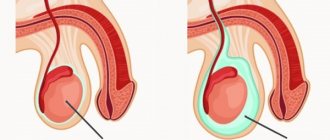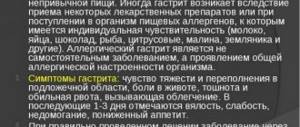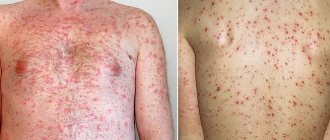Causes
With regard to the etiology of bronchitis, it is necessary to distinguish between predisposing factors and the actual causes. Predisposing factors usually include meteorological conditions. There is no doubt that individual meteorological factors - cold, heat, humidity, etc. - with an unfavorable combination create a predisposition to the development of respiratory diseases. The most unfavorable conditions that have a harmful effect on the mucous membrane of the respiratory tract are frequent changes in air temperature due to dampness and cold winds.
Also, inhalation of dust (flour, tobacco, coal, metal, etc.), harmful gases and vapors (especially vapors of nitrous and nitrous acid, sulfuric acid, hydrochloric acid, chlorine, etc.) contributes to the development of bronchitis.
Some personal predisposing conditions that may exist for a long time or temporarily are also important. Delicate physiques, weak, anemic faces, as well as people exhausted by serious illnesses, easily become ill with bronchitis.
In terms of gender, male predominates, which is explained by occupation and lifestyle.
Of the ages, children and old age are most prone to bronchitis. In childhood, there is a lack of resistance to various causes of bronchitis. In old age, a greater tendency to bronchitis is explained by the lack of resistance of poorly nourished tissues, general weakness of the body and partly the changes in the heart and blood vessels that occur in old age. Starting from the age of 5, the predisposition to acute bronchitis decreases, and in adolescence and adulthood it is the least.
Residents of warm countries who move to colder countries easily become ill with so-called acclimatization bronchitis. On the contrary, residents of cold countries are less likely to develop bronchitis when moving to warmer areas, since they are less sensitive to weather changes.
In addition to the mentioned predisposing conditions, one should also point out the weakening of the bronchial mucosa caused by other diseases. Thus, heart disease (especially mitral defects), various intrathoracic diseases (aortic aneurysms, mediastinal tumors, diseases of the lungs and pleura), kidney diseases, gout, alcoholism, syphilis, etc. contribute to the development of bronchitis.
However, whatever the predisposing factors, bronchitis does not occur without the main cause - pathogens. Most often, the disease is caused by pneumococci, streptococci and staphylococci, as well as influenza virus, measles, etc.
What is asthmatic bronchitis
Infectious-allergic damage to the bronchi, characterized by excessive mucus secretion, swelling and spasm of the mucous surfaces of the lower respiratory tract - a disease with an asthmatic component. Asthmatic bronchitis is not accompanied by attacks of breathlessness, unlike bronchial asthma. Medicine regards this type of bronchitis as a harbinger of the development of asthma, which is caused by ignoring symptoms and untimely treatment.
Pathological anatomy
Changes in the mucous membrane during bronchitis consist of hyperemia, swelling and increased secretion. These changes are not always expressed to the same degree, but, on the contrary, in some cases one of them predominates, then the other. Hyperemia is either evenly distributed over the entire mucous membrane of the windpipe and partly of the large bronchi, or is noticed only in places; The color of the mucous membrane in acute bronchitis is bright red, in chronic and especially secondary bronchitis it is dark red or blue-purple. In mild forms, hyperemia is limited only to the superficial layers of the mucous membrane, but in severe forms it spreads to deeper layers. In acute primary bronchitis, for the most part only the mucous membrane of the lower part of the trachea, large and partly middle bronchi turns red, while in secondary bronchitis the redness spreads more or less evenly to the mucous membrane of the smaller bronchi. In chronic bronchitis, the mucous membrane is sometimes slate-gray in color and presents only isolated hyperemic areas in places.
Swelling of the mucous membrane depends on increased vascular injection, inflammatory tissue changes (cellular proliferation) and serous infiltration. Only with severe bronchitis do all layers of the bronchial wall become swollen. In milder cases, the swelling is limited to the mucous membrane itself, where the catarrhal process begins. In this case, the swelling is moderate, the mucous membrane has a swollen, velvety appearance; on the contrary, in severe cases it is loosened and thickened, the walls of the bronchial tubes are dense, thick, their lumen, due to the relaxation of the elastic and muscular elements, is somewhat wider than usual.
Swelling is most pronounced in chronic, often aggravated bronchitis. The mucous membrane in such cases is covered with papillary growths containing many vessels, and, as a result, is bumpy and uneven; with a dense arrangement of growths, it has a fleecy, granular appearance. The growths are located more in the longitudinal direction than in the transverse direction. The medium, small and smallest bronchi often also take part in this hypertrophy; it is in them that the growth of connective tissue and sometimes also hyperplasia of cartilage occurs. As a result, the lumen of the bronchi is significantly reduced and may even undergo obliteration.
Serous infiltration or edematous swelling is observed mainly in secondary bronchitis, and the mucous membrane has a greasy, shiny, velvety appearance.
Ulcerations of the mucous membrane are extremely rare in bronchitis; on the contrary, larger or smaller superficial epithelial defects are observed quite often.
Histological changes in chronic bronchitis are extremely varied. In general, we can say that with prolonged or frequently recurring inflammation of the bronchi, specific elements of the bronchial wall die, and either a thinning of the wall occurs, which turns into a thin, dense, although containing connective tissue membrane, or, conversely, thickening due to abundant proliferation of connective tissue, displacing all other wall elements.
The separation of the bronchial mucosa is changed qualitatively and quantitatively. In acute bronchitis in its first stage, when the mucous membrane is dry and swollen, there is almost no separation or only a scanty, mucous, viscous and transparent secretion containing very few cellular elements is separated. In the second stage, the compartment contains more cellular elements, especially purulent bodies, but at the same time it is cloudy, more compact and lumpy.
In chronic bronchitis, the discharge can be watery-mucosal, purulent-mucosal or purely purulent, sometimes scanty, sometimes extremely abundant.
Lung tissue in acute inflammation of the large bronchi and trachea is usually normal; Only with simultaneous inflammation of the small and minute bronchi does catarrhal pneumonia sometimes occur. In old chronic bronchitis, especially of small bronchi, growth of the interstitial connective tissue of the lungs also occurs; in addition, with them there is mostly pulmonary emphysema, partly vicarious, partly essential, developing as a result of coughing attacks and increased expiratory pressure. Finally, with bronchitis, atelectasis and sometimes adhesive pleurisy are observed.
Alternative medicine methods
Traditional recipes for bronchitis with an asthmatic component should be used in combination with traditional medicine, after consulting with your doctor. Self-prescription of drugs can cause the manifestation of additional allergic symptoms, which provokes the transformation of the disease into bronchial asthma. The list of effective folk methods includes drugs prepared according to the following recipes:
Honey and turnip juice for asthmatic bronchitis
- Honey and turnip juice are mixed in equal proportions and consumed four times a day, one teaspoon.
- 10 g of a mixture of motherwort, eucalyptus, St. John's wort and nettle are infused for 30 minutes in 250 ml of boiling water. The solution is taken for 30 days.
- 500 g of crushed aloe leaves are mixed with the same amount of honey and Cahors. After 10 days, the finished composition is used 5 g before meals.
- 15 drops of propolis tincture are added to 200 ml of heated milk. The drug is recommended to reduce coughing attacks.
- A kilogram of garlic infused in 1500 ml of alcohol is added 7 g to half a glass of milk. The garlic solution must be kept for 25 days.
- Boil 200 g of raisins in one and a half liters of water for 40 minutes. Mash the boiled berries, pour in 6 ml of onion juice. Drink for 10 days.
In conditions of timely medical care, most patients with asthmatic bronchitis manage to avoid the formation of complications.
Symptoms and signs
Acute bronchial and tracheobronchial inflammation
Independent acute inflammation of the trachea is observed very rarely, and almost always the trachea is affected together with the larynx or bronchi.
In mild cases, the disease begins with nasal catarrh, which spreads to the larynx, windpipe and bronchi. The initially dry cough soon becomes wet, and after 1-2 weeks the process ends, without any special chest symptoms.
More severe forms develop from lighter ones or appear as such from the very beginning. The general condition is severely disturbed; the patient complains of frequent chills, alternating with a feeling of heat, general weakness, fatigue, thirst, loss of appetite, a dry, sometimes very painful cough that interferes with sleep; In addition, there is shortness of breath and chest pain. When listening to the chest, dry rales are detected. The sputum is scanty and consists of more or less viscous, glassy mucus. Usually, after a few days, the cough becomes more wet, the expectorated mucous sputum is less viscous; fever, shortness of breath and chest pain decrease, wheezing becomes more moist, and the disease enters the stage of resolution; sputum becomes more abundant, looser and yellowish, cough repeats less frequently and weakens, sweat appears; urine, which previously showed changes, becomes normal; appetite, sleep, etc. are restored, and after a few days, a maximum of a few weeks, the illness ends, unless under the influence of new harmful factors, as sometimes happens, relapses occur that delay recovery.
Cough, which is one of the most important phenomena of bronchitis, is at first dry, sometimes moderate, sometimes painful, repeated in the form of attacks with a feeling of tickling and burning in the throat, sometimes convulsive, as with whooping cough. The stronger the catarrhal inflammation, the more sensitive the places that are irritated by coughing (bronchi, the bifurcation and back wall of the windpipe, interarytenoid space), and the faster, stronger and longer they react to the irritation acting on them (mucus, inhaled air, etc.). ). The interarytenoid space is the most sensitive, and therefore the cough is especially severe when this area of the larynx is simultaneously affected. The cough is also stronger and longer lasting, the more sticky and viscous the mucus. It also intensifies in a supine position, because sputum flows into the deeper parts, in which, under the influence of the supine position, hyperemia and swelling become stronger; Therefore, patients cough for quite a long time when they go to bed in the evening. Finally, the intensity of the cough also depends on the patient’s willpower; some patients (women, children) react by coughing to the slightest irritation, while others are able to suppress the irritation. When the larynx is simultaneously affected, the cough is often very loud barking and mostly hoarse.
With the appearance of more abundant discharge, in the second stage of bronchitis, the cough becomes more wet, and then, as it improves, it repeats less and less often and finally stops completely.
Chest pain often exists from the very beginning of the disease and is intensified by a dry cough. Pain, sometimes only a feeling of rawness, is felt behind the sternum, along the windpipe; sometimes it spreads to the sides of the chest and to the epigastric region.
The sputum is at first very scanty and consists of foamy, transparent, colorless and slightly whitish-gray mucus, of such a viscous, sticky consistency that it sticks to the bottom of the spittoon and does not flow out when tipped over; sometimes it is less viscous and viscous.
The stickier the mucus, the more difficult it is to expectorate; at the same time, it becomes more foamy, the more the patient has to cough to remove it. Sometimes veins and spots of blood are visible in the sputum due to rupture of capillaries during a tense cough. Little by little, the mucous sputum becomes less transparent, less viscous and sticky, yellowish in places, more abundant, and it is easier to expectorate when coughing. Children under 10-12 years of age usually do not produce sputum at all, because they swallow it.
Dyspnea in acute bronchitis of large bronchi is either completely absent or exists only to a small extent.
Percussion sound, even with severe bronchitis, does not represent any changes. When listening, dry wheezing is found in the first stage, namely with severe swelling of the mucous membrane of the trachea and large bronchi or with the deposition of viscous, sticky mucus on the mucous membrane - buzzing wheezing, while with simultaneous swelling of the mucous membrane of small bronchi - whistling. These wheezes are sometimes so loud that they are heard not only at the place where they arise, but are heard throughout the chest and are audible to the patient himself and those around him. Often they are also felt with a hand attached to the chest. Vesicular breathing is more or less muffled, and where it is heard, it is either weaker or harsher than normal. In the second stage, when the sputum becomes thinner and more abundant, moist rales appear, which in the area of the trachea and large bronchi have a large-bubble character. With a decrease in separation and improvement in the course of the disease, wheezing disappears.
There are usually no symptoms from the nervous system, with the exception of a mild headache at the onset of the disease. Sleep suffers for the most part only due to cough, less often due to fever. As the cough subsides, sleep also returns.
Digestive disorders (coated tongue, loss of appetite, thirst, etc.) are observed only at the beginning and often disappear after a few days. Vomiting occurs in most cases only during severe coughing attacks.
Urine output in the first days of illness, during a febrile rise in temperature, is sometimes reduced; at the same time, the urine is dark red in color, has a higher specific gravity, contains more urea and, when standing, often gives a brick-red sediment consisting of uric acid salts.
Fever occurs in acute tracheobronchitis only for a short time; it has a laxative, rarely intermittent character, lasts several days, after which in approximately half of the cases it stops completely. Only in children it usually lasts longer. The temperature usually rises no higher than 39°C. The skin is initially hot and dry, but later, as with all catarrhal fevers, a tendency to sweat appears. A sudden drop in temperature, as with pneumonia, is never observed, but, on the contrary, the temperature always drops gradually. In old people, even with severe bronchitis, there is no fever at all, or it is very insignificant. The more the inflammatory process is limited to the large bronchi, the less elevated the temperature. The pulse usually corresponds to the temperature.
For the most part, acute tracheobronchitis ends in recovery; Only in very weakened and exhausted patients, in young children or old people, can it sometimes lead to death. In some cases, the disease, due to repeated returns, becomes chronic.
2. Bronchiolitis
Capillary bronchitis (bronchiolitis) usually occurs as a result of the transition of inflammation from large to small bronchi; in other cases, small bronchi are affected from the very beginning and from them the inflammatory process moves to larger bronchi.
Capillary bronchitis differs, on the one hand, in that it soon causes difficulty breathing (in children and old people), and on the other hand, in that it easily develops into lobular catarrhal pneumonia.
Breathing is always accelerated and often so significantly that there is very severe shortness of breath. The lips, ears, cheeks and nose may be bluish. With severe shortness of breath, patients are restless and are sometimes forced to sit down to ease their breathing; the latter occurs with the participation of auxiliary respiratory muscles and is accompanied with every inhalation by a clear expansion of the wings of the nose. Respiratory movements are short, often jerky and superficial. Sometimes, with severe shortness of breath, retraction of the jugular fossa and epigastric region is observed during inspiration due to the fact that inspiratory pressure is not able to stretch the lungs, due to widespread blockage of the smallest bronchi and pulmonary alveoli.
In adults, shortness of breath is usually less severe. In infants and young children in general, the condition is, on the contrary, often very alarming and shortness of breath is often associated with attacks of suffocation.
Anxiety and sadness are strongly expressed. Very weak children lie mostly motionless, their pulse is small, sometimes cannot even be counted, their faces are cyanotic, shortness of breath is severe; only from time to time they cough. In young children, the increase in shortness of breath at the beginning of diffuse or capillary bronchitis with insufficient attention is often visible and the condition suddenly takes on a very alarming character when shortness of breath reaches its maximum. In old people, shortness of breath usually develops gradually and imperceptibly. They often have an asthmatic type of breathing.
In pure cases of general and capillary bronchitis, the percussion sound is unchanged; Only in the presence of complications (lobular atelectasis, lobular catarrhal pneumonia, compactions, etc.) are deviations observed in this regard. In acute pulmonary distension, the clear sound extends beyond the normal limits of the lungs and the pulmonary-hepatic border is located lower than normal. Cardiac dullness in general bronchitis is sometimes increased in the transverse direction.
The most important results come from listening. A wide variety of wheezing can be heard in the chest area, both dry (buzzing, whistling) and wet (large, medium and small bubbles). Depending on whether large and small bronchi are simultaneously affected (with general bronchitis), or only the smallest bronchi (with capillary bronchitis), wheezing is heard either everywhere or only in limited places. With capillary bronchitis, whistling and fine rales predominate. Vesicular breathing, where it is not muffled by wheezing or is absent due to obstruction of parts of the lungs, is either weak or harsh; exhalation is always lengthened.
Wheezing in different places of the chest is extremely heterogeneous; they are sometimes dry, sometimes wet, and in the latter case they have either a coarse-bubbly, or medium-bubbly or fine-bubbly character in the same place; at the same time, vesicular breathing is sometimes audible, sometimes inaudible. The cough is mostly dry, short, painful, often convulsive. The sputum is initially very scanty and, as in acute tracheobronchitis, sticky, mucous, glassy and transparent. After some time, it becomes yellowish, mucopurulent and thicker. The phlegm originating from the smallest bronchi is less mixed with air and therefore sinks in water.
Fever is a constant occurrence in acute diffuse and capillary bronchitis, but it remains moderate and rarely exceeds 39°C; it presents morning remissions and evening exacerbations and lasts more or less long, depending on the degree, intensity and prevalence of bronchitis, as well as the age and physique of the patient. Sudden strong increases in temperature depend in most cases on the associated catarrhal pneumonia and are for the most part the only initial symptom of such a complication.
Cardiac activity and pulse are usually very frequent, and in this respect there is no correspondence with temperature.
The skin is initially dry and hot to the touch; subsequently, as with all catarrhs of the respiratory tract, there is a tendency to sweat. In very severe cases, especially those accompanied by suffocation, in which there is widespread blockage of the bronchi and an abundant accumulation of carbon dioxide in the blood, cyanosis is noticed not only on the face, but also on the torso and limbs.
Urine flow, as in acute tracheobronchitis, is initially reduced; urine has the properties of febrile urine, contains a lot of uric acid salts, and in severe cases, with severe venous stagnation, a little protein.
Brain phenomena depend on carbon dioxide intoxication and fever. In mild cases they do not occur at all and are generally insignificant in adults; on the contrary, in children and old people they are often quite severe.
Digestive disorders to a minor extent (lack of appetite, coated tongue, etc.) are observed constantly and for the most part last more or less long. Children often experience vomiting and diarrhea.
The feeling of tightness in the chest, general weakness and weakness of the patients are more or less pronounced. In addition, with diffuse bronchitis, there is pain in the chest or behind the sternum; with independent pure capillary bronchitis they do not occur.
Capillary bronchitis is extremely often complicated by catarrhal pneumonia; in children this is almost the rule. In addition to catarrhal pneumonia, atelectasis and acute emphysematous swelling are often observed in the lungs with capillary bronchitis.
With severe capillary bronchitis accompanied by frequent coughing, children always develop capillary cylindrical bronchiectasis, which disappear again after recovery. When inflammation becomes chronic, sometimes persistent and also sac-like bronchiectasis can form.
The location of the tubercle always worsens under the influence of capillary bronchitis.
Complications from the pleura are rarely observed.
Acute diffuse and capillary bronchitis is also a rather serious illness in adults, although it only rarely ends fatally in them; in the worst case, it leaves behind small lumps or chronic bronchitis. In children, on the contrary, this disease is very dangerous. In older children, whose cough is vigorous enough to remove mucus from the bronchi, and also with a slight spread of inflammation, the prognosis is more favorable. In old people, diffuse acute and capillary bronchitis is always a very serious illness, since they can always experience loss of strength and death.
Fibrinous (plastic) bronchitis
This includes those cases in which in the sputum there are formations in the form of bundles, which, when transferred to water, straighten out and with their tree-like branched shape indicate that we are dealing with casts of bronchial branches. These bronchial convolutions are contained in simple catarrhal or more or less bloody sputum; They are sometimes completely white, sometimes yellowish-white, sometimes, due to the admixture of blood, entirely or in places reddish, less often dark red. Their thickness varies, like the lumen of the bronchi, from a few millimeters to several centimeters or more; their length is several, sometimes even 10-15 cm. A cross-section often shows a layered structure.
These bundles consist partly of fibrin, partly of mucus or a mucin-like substance; in the first case they talk about fibrinous bronchitis, in the second – about false membranous bronchitis.
When examined microscopically, fibrin bundles consist of thin, partly wavy, partly intertwined fibers in the form of a network, located in the hyaline ground substance; mucous convolutions represent a rough concentric layering and consist of highly light-refracting plates with fine granularity, interconnected by transverse crossbars.
Fibrinous bronchitis occurs after inhalation of highly irritating vapors and gases (hot water vapor, ammonia, etc.), then with diphtheria, both spreading from the pharynx to the bronchi, and developing in rare cases initially in the bronchi and then spreading upward, and how a particular phenomenon of pneumonia. In such cases, the resulting bronchial casts consist of fibrin, and in diphtheria and pneumonia they are usually not solid, but have a tubular shape.
As a secondary process, fibrinous bronchitis sometimes develops with certain skin diseases (impetigo, herpes, especially pemphigus), then during or after infectious diseases (typhoid fever, pneumonia, tuberculosis), as well as with heart disease.
Idiopathic plastic bronchitis can be acute or chronic:
A) The acute form mostly occurs with severe fever, which often begins with shaking chills. The cough is initially dry and hoarse, shortness of breath often worsens in the form of attacks of suffocation; After a few days, as a rule, slightly bloody sputum containing characteristic clots is released. As they cough up, which can last for several days, the feeling of rawness and heaviness in the chest disappears, breathing becomes freer and the temperature quickly drops. The disease may then end in recovery, but often clots form in the bronchi again, the difficulty in breathing intensifies again, and only after the bronchial clots are released again does relief occur again. So the illness can drag on for several weeks, during which the patient usually suffers greatly from coughing and attacks of shortness of breath. Sometimes, however, expectoration of the packages occurs very easily.
Expectoration of parcels can be associated with hemoptysis, sometimes preceding or accompanying; The discharge of blood is usually insignificant, but can sometimes reach serious volumes. Physical examination of the chest reveals in some cases signs of acute pulmonary distention; the percussion sound is not changed; when listening, weakened vesicular breathing and fine wheezing are found in places where the bronchi are clogged with convolutions, sometimes a peculiar noise in the form of friction or crackling, depending on the vibration of individual convolutions in the bronchi.
The diagnosis of plastic bronchitis is confirmed by the presence of characteristic clots in the sputum. The prognosis for the acute form is always serious. In some cases, the disease becomes chronic.
B) The chronic, recurrent form of plastic bronchitis is more benign than the acute one. It develops mostly from simple bronchitis, often old chronic, occurs without fever or with slight increases in temperature and lasts in the form of more or less frequent attacks, without seriously affecting the general condition for years. Only when, as a result of frequent repetition of attacks, pulmonary emphysema, cardiac weakness and congestion develop, is the patient’s life in danger; in some cases, hemoptysis preceding or accompanying attacks becomes dangerous due to very heavy blood loss or frequent recurrence of bleeding. The frequency of attacks varies; they occur daily, even several times a day, or are repeated rarely at intervals of several weeks, months or years. The duration of each individual attack, as well as the number of convolutions erupted during it, are also different. The attack is preceded (often) by a feeling of painful heaviness and tightness in the chest; the attack itself is associated with severe coughing and shortness of breath, although not to the same extent as in the acute form. The physical symptoms are the same as in the acute form, but they are less severe.
Chronical bronchitis
Just as in acute forms, so in chronic bronchitis, the mucous membrane of the trachea is simultaneously affected, which in both cases, however, does not significantly affect subjective disorders and the picture of the disease.
Chronic bronchitis is either an independent disease, or it develops secondary to other diseases: heart defects, diseases of the lung tissue, pleurisy, intrathoracic tumors, syphilis, gout, diabetes, chronic alcoholism, etc.
The chronic form develops after repeated or neglected acute bronchitis, or from the very beginning imperceptibly and gradually under the influence of long-term minor harmful influences (frequent colds, exposure to dusty air, etc.). Secondary bronchitis usually begins gradually.
Chronic bronchitis is most often general and exists for the most part in both lungs and in the bronchi of all orders, but still it is most pronounced in the larger and middle bronchi and in the posterior, lower and middle sections of the lungs.
Symptoms for chronic bronchitis are generally the same as for acute bronchitis. Chronic secondary bronchitis is the same symptom complex, with the only difference being that its course is more or less modified by the underlying disease.
The mild form of chronic bronchitis is expressed in the fact that patients in the morning upon waking up cough for a short time and expectorate a small amount of mucous gray-yellow sputum, after which they are not bothered by coughing for the whole day. There is no shortness of breath or it is insignificant and is noticed only when coughing and during strong movements (climbing stairs, etc.). There is generally no pain or it is felt only temporarily after coughing in one place or another of the chest; in old cases there is also some pain in the region of the liver, depending on the successive congestive swelling of the liver. The temperature is always normal, the general condition is not impaired.
In more severe cases, cough, sputum production and shortness of breath continue to a moderate degree throughout the day, in very severe cases there are severe coughing attacks during the day and even at night, with greater or lesser intervals, in addition there is severe shortness of breath, cyanosis of the lips, ears , palpitations, dyspeptic disorders. There is also severe, sometimes constant chest pain that appears as a result of a painful cough.
Shortness of breath, cough and sputum production usually decrease in the summer, and in less severe and not very old cases, so much so that patients feel that they have gotten rid of bronchitis. However, with the onset of a colder season, subsided bronchitis becomes aggravated again due to colds, to which patients are exposed due to their profession, or due to new exposure to various harmful influences. Thus, cough, sputum production, shortness of breath worsen from year to year.
An occasional exacerbation of bronchitis can, especially in frail and elderly people, be life-threatening, but death is rare. In most cases, subjective disorders intensify quite gradually and can last for years, even decades, until old age. However, over time, serious secondary changes occur in the form of pulmonary emphysema and bronchiectasis, hypertrophy and dilatation of the right ventricle and fatty degeneration of the heart, as a result of which the disorders intensify to a painful degree. There is severe shortness of breath all the time, the cough does not give the patient rest either day or night, cyanosis becomes more widespread, swelling in the legs, abdominal dropsy and albuminuria appear. Often these severe phenomena can also drag on for years, sometimes getting better, sometimes getting worse.
Diagnostics
The presence of symptomatic signs requires that you visit a doctor. The diagnosis includes several steps:
- The doctor conducts a comprehensive examination;
- Collection of information about medical history, living conditions, past illnesses;
- When listening, breathing is hard, wet wheezing;
Then the doctor sends the patient for tests and tests. It is important for the doctor to find out the type of allergen due to which the allergic reaction occurred, in this case he refers to:
- Skin donation. Several tests are carried out.
- Submitting mucus for a sample. A culture is carried out, after which the type of infectious bacillus and intolerance to various groups of drugs are determined.
It is mandatory for the doctor to take an x-ray of the pulmonary organs. The doctor may prescribe an additional examination: spirometry to measure lung volume, expiratory volume in 1 second and expiratory speed, as well as pneumotachography to determine the degree of patency in the bronchial canals.
Treatment
Treatment of bronchitis depends on the etiology and form of the disease. Acute chronic bronchitis of viral etiology often goes away on its own within a week. For diseases caused by bacteria, antibiotics are used. Medications that help thin and expectorate sputum are used as adjuncts. Drinking plenty of fluids, bed rest, limiting spicy foods, smoking, etc. are also indicated.
To treat bronchiolitis, oxygen therapy, analeptic drugs, antibiotics, mucolytics, etc. can be used. In severe cases, intensive care in intensive care may be required.
Treatment of chronic bronchitis is aimed at stabilizing the patient’s condition, as well as slowing the progression of the disease.
Preventive measures
In order to prevent exacerbation and reduce the likelihood of bronchitis with an asthmatic component, medical experts recommend:
- eliminating contact with various allergens;
- undergoing a hyposensitization procedure;
- timely treatment of infectious pathologies;
- When diagnosing the disease, observation by specialized specialists is necessary.
Regular wet cleaning of household premises, getting rid of carpets and soft toys, avoiding the use of products containing allergenic substances is the basis for eliminating environmental factors that provoke asthmatic bronchitis. To strengthen your general condition, you should devote time to hardening procedures, swimming, and various aerobic exercises.












